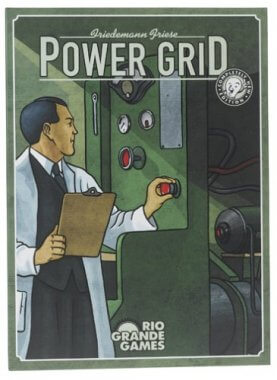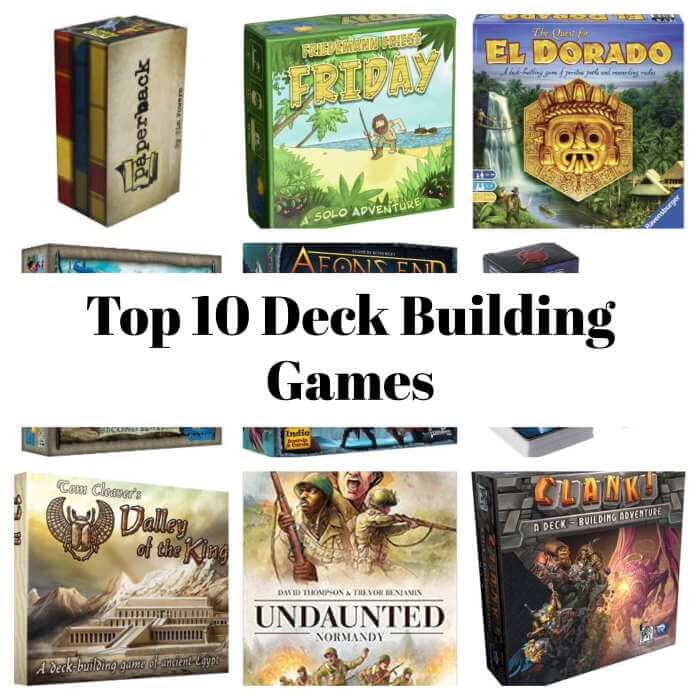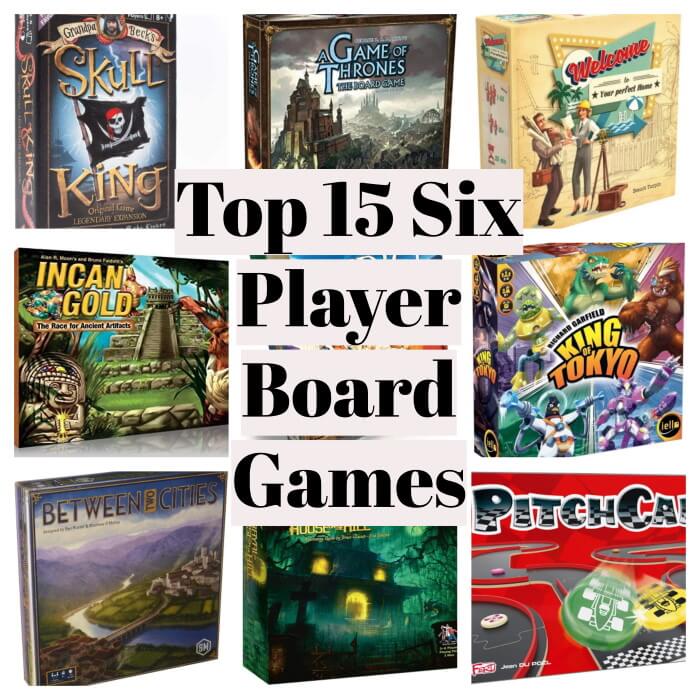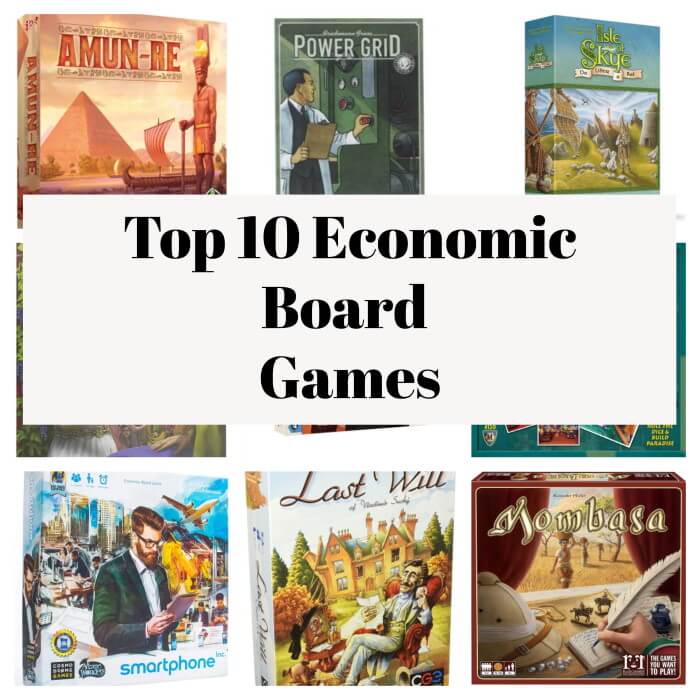
Buy low, sell high, price out your opponents, and get rich quick. If you are interested in the idea of board games that simulate economics in one way or another, then you’ve come to the right place.
In this article, we highlight 10 of the best economic board games currently available to help you channel your inner billionaire.
The category of economic board games is a difficult one to define, and one that many gamers can often interpret differently.
According to BoardGameGeek, economic games “encourage players to manage a system of production, distribution, trade, and/or consumption of goods. The games usually simulate a market in some way.” For some, elements like stock markets and trading come to mind with this category, and others consider games that include any form of resource management to be economic.
For the purposes of keeping this list of games focused, the games in this list each include a central aspect of money-management, and allow players to interact with some kind of market or similar mechanism that can change throughout the course of the game.
1. Power Grid – Being in the Lead Isn’t Always Best
In Power Grid, designed by Friedemann Friese, players compete to become the most successful power-supply company in the 20th century. They do so by purchasing power plants through an auction, buying resources to provide power to those power plants, and expanding their network on a map on the main game board.
At the end of a round of this game, players can use power plants to provide power to a certain number of cities on the board, which is the main source of money for the game. Whichever player manages to power the most power plants on their final turn is the winner of the game.
Whichever player manages to power the most power plants on their final turn is the winner of the game.
Power Grid at a Glance
| Game Type Economic, Auction/Bidding, Catch the Leader, Network and Route Building | Play Time 120 mins | Skill/Complexity (3.5 - 5) Medium |
| Age 12+ | Publisher(s) Rio Grande Games | Published 2004 |
| Categories Strategy | Players 3 - 6 (4 - 5 is Ideal) | Rules Manual Official Rules PDF |
| Our Rating 9/10 | Cost $44.99 |
One central aspect to Power Grid that makes it a brilliant design is its clever use of turn order in the game. At the beginning of each round, player order is determined based on the number of cities each player owns on the main game board.
While the auction for power plants is carried out in order of first to last on the turn order track, other critical phases – such as purchasing resources and building houses – are carried out in reverse turn-order. This slight change has huge strategic implications for the decisions players make over the course of the game, since being lower on the turn order track can provide an enormous advantage by providing access to cheaper resources and important spots on the map.
The way in which the central resource market works is also a source of some tense player interaction. It’s very simple in the sense that goods are placed onto the market from right to left, and when players purchase a resource, they take the left-most resource of that type and pay the cost associated with that space. On the one hand, this means that if a player buys multiple resources of the same type, they can make that resource extra-costly for other players who need it – and turn order can be crucial in this regard. On the other hand, this market mechanism forces players to pay attention to the types of power plants other players are buying as to avoid getting caught up in competition for the same type of resource with multiple players.
Power Grid contains many elements that are extremely well-designed and provide difficult decisions and planning without being intimidating or rules-heavy. In fact, Power Grid can be a relatively easy game to teach since each round is broken up into several easily-digestible phases. Yet, managing money in Power Grid to create a strong economic engine can be a significant challenge as it requires you to account for several factors, such as investment vs. return.
This is a game that everyone should try at least once as it truly is a remarkable design and remains a classic within the hobby.
2. Mombasa – A Kitchen-Sink of Game Mechanisms
Alexander Pfister has become a well-renowned modern board game designer, having produced a number of hits in recent years on a fairly wide spectrum of game types and complexity (including one that will be mentioned later in this list).
One aspect of game design that Pfister does particularly well is managing to bring together different game mechanisms and make them work quite smoothly. Mombasa, released in 2015, is a great example of this.
Mombasa includes an incredibly wide range of mechanisms, from deck-building, action selection, worker placement, area control, and stock market.
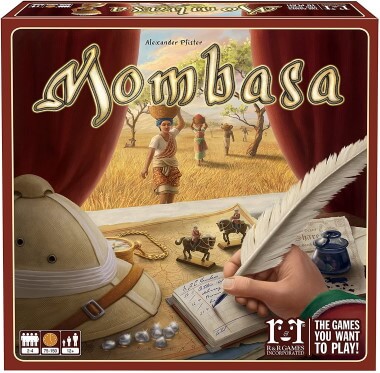
Mombasa at a Glance
| Game Type Economic, Action Queue, Area Majority/Influence, Card Drafting, Deck Building, Investment, Simultaneous Action Selection, Stock Holding, Variable Player Powers Worker Placement | Play Time 75 - 150 mins | Skill/Complexity (4 - 5) Heavy |
| Age 12+ | Publisher(s) Eggertspiele and Others | Published 2015 |
| Categories Strategy | Players 2 - 4 | Cost $44.99 |
| Our Rating 9/10 |
The basic idea of the game is that players are investors in chartered companies in the African continent, and the goal of the game is to have the most wealth in the end. One of the most prominent ways that players can earn money in the game is by acquiring shares of any of the four chartered companies, represented on four different stock tracks. A company’s value will be determined by the extent of its expansion throughout Africa by the end of the game – the more a company manages to expand its trading reach, the more valuable its share-owners will become.
While Mombasa does have a stock economy, it isn’t a stock-trading game in the traditional sense of the term; players do not sell stocks throughout the game, they only acquire them. Still, the stock market in this game is intriguing, because the further a player moves up a track in any of the four companies, they can unlock certain bonuses or action spaces that they can utilize on future turns.
Another really excellent mechanism in the game is in its card play. At the beginning of each round, players simultaneously choose 3 cards from their hand to place in front of them in any of the three available spaces on their personal player board. While these cards determine the sorts of actions a player can perform on their turn, there is also another element of planning involved. At the end of their turn, players move the cards up to their respective individual discard pile, and then pick one of the three discard piles to pull back into their hand for future turns. This decision of not only which cards to play, but which slot to place them in with future turns in mind, can be extremely challenging.
There’s no question that Mombasa is certainly complex with its many moving pieces, but it’s one that fans of heavier Euro-style and economic games are very likely to find extremely satisfying.
A potential downside to the game is in its colonization theme, which some people may not find particularly agreeable. Pfister does address this concern in his rulebook, and points players to additional research on the underlying theme.
3. Amun Re – A Reiner Knizia Classic with Blind Bidding
With 700 published games, there’s no question that Dr. Reiner Knizia is easily one of the most prolific board game designers of all time. He is also well-known for his games that feature unique auction mechanisms, and Amun Re, first published in 2003, is no exception.
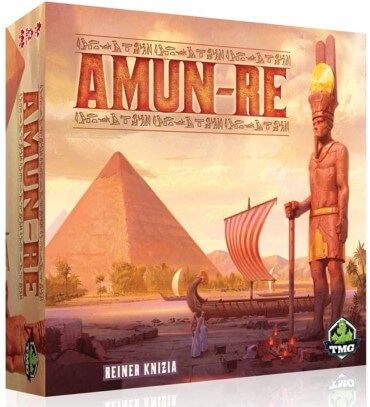
Amun Re at a Glance
| Game Type Ancient Theme, Economic, Action Queue, Area Majority/Influence, Auction/Bidding, Auction: Fixed Placement, Constrained Bidding | Play Time 90 mins | Skill/Complexity (3 - 5) Medium |
| Age 12+ | Publisher(s) Tasty Minstrel Games and Others | Published 2003 |
| Categories Strategy | Players 3 - 5 | Cost $30.99 |
| Our Rating 8.4/10 |
In Amun Re, players are pharaohs attempting to build up the most successful empire by purchasing regions on the board from an auction, building pyramids, and offering their gratitude to Amun Re. The game arc is interesting as the game is divided into two halves; in the first half, players buy regions and build pyramids on those regions (a primary way of scoring points), and in the second half players remove their player markers from the board and re-auction regions with the pyramids still intact. In this sense, players can purchase regions and hit the ground running for VP generation in the second half of the game, also meaning that bidding can become quite intense.
The game also includes a blind-bidding mechanism in which players decide how much money they would like to offer to Amun Re. The collective value of all players’ offerings then determines the amount of money players get for farmers and caravans in their regions. Having a low collective offering value offers rewards for players with caravans, while having a high offering can equate to more income for players with farmer tokens. Also, whichever player has the highest offering gets additional bonuses and becomes the starting player for the next round. This can create some challenging choices as players look at the types of regions they have and try to map out what a smart offering amount might be based on what they think other players might offer.
Amun Re is a great pick for players looking for a game that rewards smart decisions based on guessing other opponents’ moves, as well as good planning in terms of money management.
This could also be a great game for players who appreciate the ancient Egyptian theme – the most recent edition from Tasty Minstrel Games has incredible component quality in which big hefty pyramids create a stunning visual presence on the game board.
4. Concordia – A Masterpiece of Simplicity
The mark of an excellent board game design sometimes isn’t a complex ruleset, but streamlined rules and simple turns that offer deep and meaningful choices over the course of the game.
Concordia, designed by Mac Gerdts, is one of these games in that players do one thing on their turn: play a card, and execute its associated action. Yet, even within that simple design lies some excruciating decisions a player must make in order to do well and win the game.
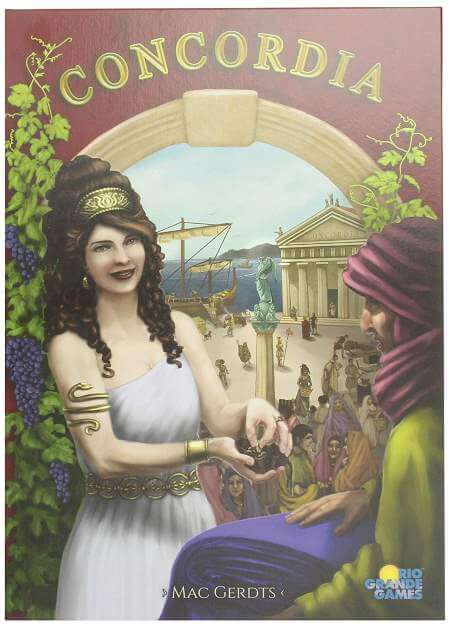
Concordia at a Glance
| Game Type Ancient Theme, Card Game, Economic, Deck Building, Variable Set Up, Point to Point Movement | Play Time 90 mins +/- | Skill/Complexity (3 - 5) Medium to Heavy....ish |
| Age 12+ | Publisher(s) Rio Grande Games and Others | Published 2013 |
| Categories Strategy | Players 2 - 5 (4 is Ideal) | Manual Official Rules |
| Our Rating 9.5/10 | Cost approx $44.99 |
In Concordia, the goal of the game is the get the most points through expanding an economic empire around a map, collecting resources and income (and spending them wisely on future turns), and collecting additional cards to be able to perform different kinds of, or more powerful, actions on the game board. However, apart from the actions the cards provide, they provide a secondary – and perhaps more important – benefit in that they are the source of VPs at the end of the game.
In Concordia, the goal of the game is the get the most points through expanding an economic empire around a map, collecting resources and income (and spending them wisely on future turns)………
Points in Concordia are not calculated until the very end of the game. At that point, players achieve points by meeting certain conditions from the cards in their deck (for instance, number of regions where they have a house, and each type of good their regions produce). In other words, players can spend the entire game expanding around the board, gaining money, buying and selling resources, and buying a ton of cards for their deck, but unless they can manage to effectively execute the scoring conditions from those cards, they will not win the game.
One really fascinating economic aspect of the game is how the central resource and money market functions. Each region on the game board produces a good, as depicted on its bonus marker.
On their turn, players can use their Prefect card to collect the associated resource for any region on the board (even if they don’t have a house there). However, all players will gain 1 of the same resource for each house they own in that region. Once a player collects a region’s resource, they flip the bonus tile to the opposite side, which shows money (either 1 or 2 coins).
The other option players have with the Prefect card is to collect money – equal to the total amount of money shown on all regions’ bonus tiles. In this case, all bonus tiles are then flipped back to their original resource side, and players can once again can use these tiles to collect resources rather than money. This means that a player needs to decide at what point it’s worth it to collect money (which is incredibly valuable in the game), but in doing so they open up those resource tiles to be used again by other players.
If you are looking for a game that is especially easy-to-learn (and teach), then Concordia is definitely one to check out. With a rulebook of only 4 pages, which you probably won’t need to consult much once you’ve read through it once, it’s easy to see even after just one play of Concordia why it has managed to establish itself in the gaming community as a solid mid-weight economic Euro game.
5. Isle of Skye – A Unique “Set Your Own Price” Tile-Laying Auction Game
Isle of Skye, designed by Alexander Pfister, is an award-winning game that proves it’s possible to take a well-known mechanism and add in some extra layers of depth in order to provide a gaming experience that’s both satisfying and distinct.
Carcassonne is an extremely successful tile-placement board game in which players place tiles from a bag in order to build and match terrain to complete structures like roads and cities. At its core, Isle of Skye is based on this same premise, but with the addition of economic elements as well as variable scoring conditions.
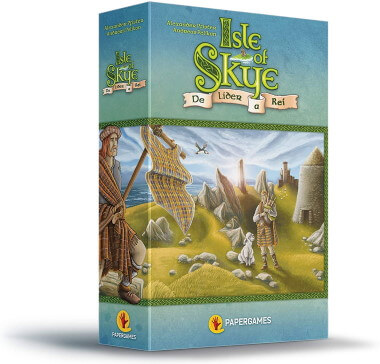
Isle of Skye at a Glance
| Game Type Economic, Auction/Bidding, Catch the Leader, Set Collection, Tile Placement, Turn Order: Progressive | Play Time 30 - 50 mins | Skill/Complexity (2.5 - 5) Light - Medium |
| Age 8+ | Publisher(s) Mayfair Games and Others | Published 2015 |
| Categories Strategy / Family | Players 2 - 5 | Cost $31.99 |
| Our Rating 8.8/10 |
In contrast to other tile-laying games in which players draw a tile and decide where to place it, Isle of Skye has players draw three tiles and then secretly and simultaneously assign a price to each tile behind a player screen which other players must pay in order to purchase that tile and place it into their province. The tricky part of this decision process is that players use coins from their own supply to assign a cost to each tile, and they must purchase the tiles that no other players buy from them by the end of the round. For instance, if a player prices a tile at 7 coins, but no other player buys that tile, they lose those 7 coins to the bank but gain the tile to place in their province.
The other interesting economic element to the game is that players receive money at the beginning of each round for each barrel in their province that connects back to their main castle via roads. Because players earn points for completing certain objectives during the scoring phases of the game, they often have to decide whether to purchase tiles that will provide ongoing income or will help them achieve more points during scoring. Money is crucial, but you can’t win the game without points.
The other interesting economic element to the game is that players receive money at the beginning of each round for each barrel in their province that connects back to their main castle via roads.
All-in-all, if you are looking for a “next-step” game to play or introduce casual gamers to after you have played some gateway-style games like Carcassonne, then Isle of Skye can be a game that suits that category very well. It has a very short game length of 30-50 minutes, so it’s easy to play multiple rounds in a row if players are in the mood.
6. Stockpile – A Stock Market Game with Insider Information
When thinking about what exactly constitutes an “economic” game, it’s hard to deny that games that feature a stock market represent the category quite well. And while there are many games out there that include mechanical stock-market elements, Stockpile is a game that manages to capture the thematic feel of stock market investment in a way that is both fun and accessible to new players.
When thinking about what exactly constitutes an “economic” game, it’s hard to deny that games that feature a stock market represent the category quite well.
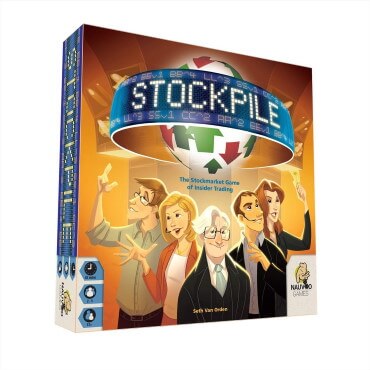
Stockpile at a Glance
| Game Type Economic, Auction/Bidding, Auction: Fixed Placement, Card Drafting, Commodity Speculation, Constrained Bidding Investment, Market, Stock Holding, Victory Points as a Resource, Kickstarter | Play Time 45 mins | Skill/Complexity (2.2 - 5) Light - Medium |
| Age 13+ | Publisher(s) Nauvoo Games and Others | Published 2015 |
| Categories Strategy / Family | Players 2 - 5 | Cost $34.99 |
| Our Rating 8.9/10 |
Stockpile, designed by Brett Sobol and Seth Van Orden, is a game in which players take on the role of corporate investors who all have bits and pieces of insider information and seek to manipulate the market to their personal gain. The player at the end of the game who has the most money wins the game, and as you may easily guess, players gain money by buying and selling stocks at the right time.
The aspects of the game that make it especially exciting are the pieces of insider information that each player has, and the fact that the game has you constantly trying to figure out what other players might know based on the decisions they make. For instance, each player receives a piece of information at the beginning of each round that tells them how a certain stock will move at the end of the round. If a player suddenly sells a bunch of stock from one category, this might clue other players into the possibility that they know that its value is about to significantly plummet.
The game also includes a phase in which players bid on stockpiles that contain both face-up and face-down cards from the market deck, which are placed by players during the supply phase and can be either good or bad. The fact that no one knows everything included in each stock pile, but each player at least knows a bit of hidden information, means that there can be quite a bit of trying to read of other players’ moves.
Because Stockpile has a theme that many people (even non-gamers) will be familiar with and grasp, means that it can be an easy game to teach and get to the table. If the theme of stock buying and trading is interesting to you, and you don’t mind a bit of added chaos, then Stockpile is a game you will definitely want to consider checking out.
7. Last Will – Be the Best at Spending Money
In the large majority of board games, the goal is to win the game by gaining something, whether it be VPs, money, fame, or any other indication of success. Last Will, designed by Vladimir Suchý, is a game in which players want to do the exact oppose: be the first to spend all their money in frivolous and unnecessary ways.
At the prospect of inheriting a rich uncle’s wealth, players in Last Will want to be the first to spend all their money in order to prove their love and devotion to the lavish and gluttonous lifestyle. To do so, they must be very clever and creative in taking actions each turn to spend as much money as they possibly can, even going as far as paying for the honor of bringing along their horse to an event.
At the prospect of inheriting a rich uncle’s wealth, players in Last Will want to be the first to spend all their money in order to prove their love and devotion to the lavish and gluttonous lifestyle.
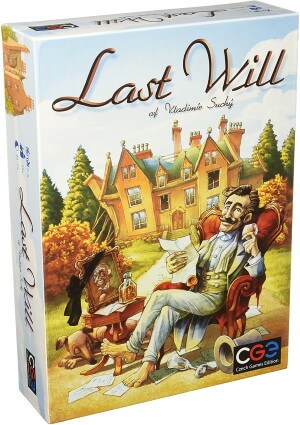
Last Will at a Glance
| Game Type Economic, Humor, Card Game, Action Points, Hand Management, Worker Placement | Play Time 45 - 75 mins | Skill/Complexity (2.8 - 5) Light - Medium |
| Age 14+ | Publisher(s) Czech Games Edition and Others | Published 2011 |
| Categories Strategy | Players 2 - 5 | Cost $49.95 |
| Our Rating 8.7/10 |
And while the idea of simply trying to spend money on your turn in order to go bankrupt sounds like an easy task, it requires a little more planning and strategic thinking in order to do it best.
For instance, one thematically-fitting element of the game is that players cannot go bankrupt if they have any properties on their estate. They can sell their properties, but this will just make them more rich, which goes against the goal of the game. Properties depreciate over time, however, making their sale value less and less, and players can also manipulate the property market, making certain categories of properties even less (or more) valuable when sold or purchased.
This idea of trying to get the absolute worst return on investment possible, and trying to spend a bunch of unnecessary money on their turn is a concept in a board game that isn’t found in many games, and it works very well here due to its theme.
Speaking of the theme, this is a game that players can have a lot of fun with, narrating their turns in ridiculous posh accents as they complain about their first world problems of needing to spend more money. If this theme sounds like it could be fun for you and your friends, you will likely enjoy Last Will quite a bit.
8. Biblios – A Filler/Lunchtime Auctioning & Set Collection Game
There are many situations where having a portable on hand that’s easy and quick to play with friends can be a huge advantage, like during a lunch break at work or in-between games at a game night. Biblios, designed by Steve Finn, is a game that falls into this category quite perfectly, and features elements of some “larger” board games, like auctioning and market manipulation, but in a timeframe of about 20-30 minutes rather than 90-180.
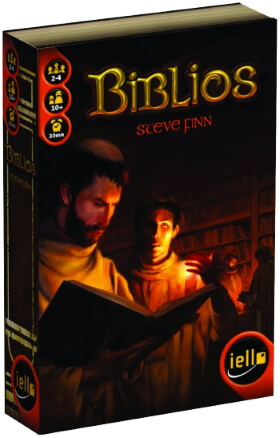
| Game Type Medieval, Religious, Auction/Bidding, Card Drafting, Commodity Speculation, Hand Management | Play Time 30 mins | Skill/Complexity (1.7 - 5) Light |
| Age 10+ | Publisher(s) Dr. Finn's Games and others | Published 2007 |
| Categories Strategy / Family | Players 2 - 4 (3 is perfect) | Cost $19.95 |
| Our Rating 8.5/10 |
The ultimate goal of Biblios is to have the most points at the end of the game by having the highest value in any 5 of the different categories of books in their collection, which they collect during two distinct phases of the game. But it’s not enough to simply try and focus on a couple categories of books and try to collect as much as you can of those types.
At the end of the game, the points that players receive for a category of books is determined by its associated die value (1-6), which is manipulated by players throughout the course of the game. In other words, if a player manages to get the majority in three categories of books, but they are only worth 1 point each, they will only receive 3 points – compared to a player that could receive potentially 12 points for winning majority in two 6-valued book categories.
Given its short play-length, it’s remarkable how much Biblios can manage to fit into a 20 to 30-minute timeframe. During the first half of the game, players take turns drafting cards into their hand, which can be book cards, money cards, or cards that allow them to manipulate the value of book categories. In the second half of the game, players still continue to collect cards, but instead acquire those cards through an auction. If a book or dice-manipulation card are revealed, players bid coins; if a coin card is revealed, players bid a number of cards from their hand (the type of card is irrelevant). As such, money becomes a crucial element in the second half of the game, and trying to decide which cards to bid high on can be a challenge. To further complicate things, bidding high on a card can reveal to other players that you are banking on winning that category, which can run you the risk of having that category’s value decreased by other players before the end of the game.
Given its short play-length, it’s remarkable how much Biblios can manage to fit into a 20 to 30-minute timeframe.
Biblios can be a roller coaster of emotion and tension as players fight for majority on different categories of books throughout the short length of the game, by snagging cards and creating a tug-of-war with dice-value manipulation.
If you are looking for a filler-length game that manages to create an experience found in more grandiose economic games, Biblios is a difficult game to pass up.
We included Biblios in the top 3 Player Games category not so long ago and found it fitted very well there as well as being a good choice within the economic board game category.
9. Lords of Vegas – Buy, Trade, and Gamble Your Way to Victory
It’s hard to imagine a more fitting setting for a game about building an economic empire than Las Vegas. In Lords of Vegas, designed by James Ernest and Mike Selinker, players attempt to fill in the vast empty space of the Las Vegas Strip in 1941 with their casinos, and ultimately become the most prosperous and influential casino owner in Sin City by gaining the most points over the course of the game.
Lords of Vegas is an economic game with some strategic planning, but yes, with a good deal of luck as well. A game set in Las Vegas wouldn’t be complete without some form of gambling, right? As players expand their empire by gaining lots and building casino tiles, they will also begin to compete with other players for control of lucrative casinos.
Lords of Vegas is an economic game with some strategic planning, but yes, with a good deal of luck as well.
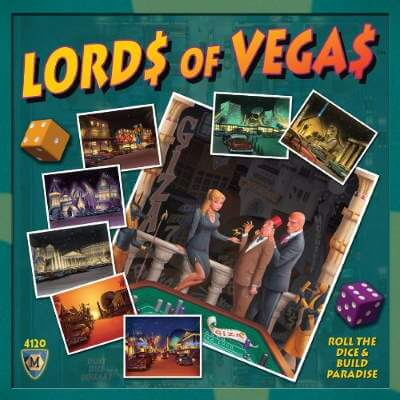
Lords of Vegas at a Glance
| Game Type Casino Theme, Tile Placement, Dice Rolling, Resources, Trading, Negotiation | Play Time 60 - 90 mins | Skill/Complexity (2.5 - 5) Light to Medium |
| Age 12+ | Publisher(s) Mayfair Games and others | Published 2010 |
| Categories Strategy / Family | Players 2 - 4 (4 is best ) | Manual Official Rules PDF |
| Our Rating 9/10 | Cost approx $48.99 |
Each turn, a player draws a casino card which determines a lot which they take control of. Additionally, the color of casino depicted on the card will pay money and points to players who have ownership in that casino. Each dice from any player in a casino of that color will get money for the collective value of their dice placed in that casino. Then, the owner of the casino (that is, the player with the highest-valued die) gets points equal to the number of tiles that make up the casino.
A couple aspects that make Lords of Vegas exciting and full of energy is the fact that players can trade with other players at any point in the game (not just on their turn), and that they can gamble in other players’ casinos. Players are able to trade basically anything in the game, including actions (when it’s their turn). That, coupled with the fact that players can gain money and VPs on other players’ turns, means that all players are constantly engaged with what’s happening, and there hardly ever feels like there is much down-time. If a player wishes to gamble in another player’s casino, they can bet up to $5 per tile in that casino. Then, they roll 2 dice, and win if they roll a 2, 3, 4, 9, 10, 11, or 12 (if they roll a 2 or 12, the casino owner has to pay double).
If you are looking for a game that is a good alternative to Monopoly, and one with a theme that many people can get excited about, then Lords of Vegas is bound to offer some memorable experiences with friends and family alike.
Lords of Vegas is included here in our roundup of board games like Monopoly and better….
The fact that the game manages to keep you constantly engaged over its 60-90 minutes of gameplay, with plenty of trash-talking and laughs along the way, means that people you introduce this game to will likely be asking to play again in the future.
10. Smartphone Inc. – A Game with a Unique Spatial Action-Selection Mechanism
As a CEO of a startup company in the smartphone industry, there are many aspects to your business that you will need to manage in order to be more successful than your competition. You’ll need to sell your goods, control market regions world-wide by selling the most goods in those regions, research technologies, and register patents. The big question is: Do you have what it takes?
Smartphone Inc., designed by Ivan Lashin, includes a very unique action-selection mechanism in which players take two double-sided smartphone pads, which contain symbols that trigger certain actions, and they must rotate and turn those boards, and overlap them in a way where at least one cell overlaps on the two pads. The actions that are visible determine the sorts of things they can do throughout the round of the game.
Smartphone Inc., designed by Ivan Lashin, includes a very unique action-selection mechanism in which players take two double-sided smartphone pads.

Smartphone Inc. at a Glance
| Game Type Economic, Action Queue, Area Majority/Influence, Network and Route Building, Simultaneous Action Selection, Solo/Solitaire Game | Play Time 60 - 90 mins | Skill/Complexity (2.8 - 5) Medium |
| Age 12+ | Publisher(s) Cosmodrome Games and Others | Published 2018 |
| Categories Strategy | Players 1 - 5 | Cost $59.95 |
| Our Rating 9/10 |
The rest of a round of Smartphone Inc. consists of players setting prices for their goods, producing goods, improving production (i.e., collecting improvement rectangles that can be used on their action pads), researching technology (i.e., unlocking special abilities that can be used throughout the game), expanding to other connected regions on the board, selling their goods, and collecting VPs. At the end of five rounds, whoever has the most points is the winner.
One intriguing aspect of Smartphone Inc. is the way that selling goods in a region works. First, players need to have goods produced and available to sell. All players have a chance to sell goods, but turn order is determined by the current sales price set by players earlier in the round – from lowest to highest.
When a player sells goods at a region, they can sell to customers who are willing to buy their product, which can be determined by maximum price they are willing to pay or that contain a certain technology they are looking for. In other words, a player who has their goods priced low with the right technologies can leave a player who with higher-priced goods with fewer customers to sell to in a given region. Not only do players gain VPs for goods they sold at the end of the round, but players who sold the most of a particular good in a region receive additional bonus points, which escalates with the more players present in that region.
While there is definitely a lot to try and balance in a game of Smartphone Inc. in order to be successful, and there is a lot of planning that players must do, the game manages to not feel too complex in terms of its rules.
It’s a game that can be relatively easy to introduce new players to, and the game flow is easy to follow along. Furthermore, the things that players are trying to accomplish during each phase of the game make sense thematically, making the actions intuitive to grasp.
If you are looking for mid-weight economic game with an interesting theme and some cool twists to make for a distinct and exciting experience, then you will likely not be disappointed by Smartphone Inc.
That’s about it for economic board games that each include a central aspect of money-management, and allow players to interact with some kind of market or similar mechanism that can change throughout the course of the game.
